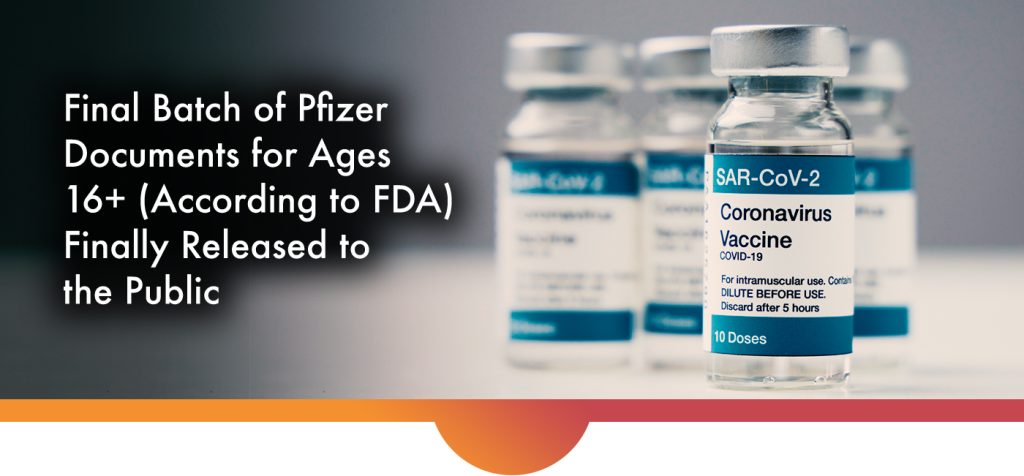

ICAN can finally announce that FDA now represents that it has produced all documents in the biologic product file of Pfizer’s COVID-19 vaccine for ages 16 and up. With this final batch, the documents, presumably those relied upon by FDA to approve the vaccine, are finally in the hands of the public, where they belong, 800 days after approval! As you’ll remember, the attorneys who represent ICAN also represent a plaintiff that won a historic lawsuit against FDA, which forced it to produce the Pfizer documents at a rate of 55,000 pages per month, as opposed to the 500 pages per month that FDA originally sought. The final batch of these court-ordered documents was just released. Now, independent scientists and researchers can see everything FDA saw when it made its decision that this vaccine was “safe and effective.”
Of the 51,893 pages in this final production, the following are of particular interest:
- CBER Sentinel Program Sufficiency Assessment – This FDA memo specifically evaluated the ability of the Sentinel Program—“FDA’s national electronic system [used to] monitor the safety of FDA-regulated medical products”—to evaluate the risk for myocarditis and pericarditis following receipt of the Pfizer vaccine. It found:
The CBER Sentinel Program is NOT sufficient to assess the serious risks of myocarditis and pericarditis, and subclinical myocarditis associated with COMIRNATY (BNT162b2) in lieu of PMR safety studies under FDAAA. At the time of BLA approval, the data sources in the CBER Sentinel Program are not sufficient to identify the outcomes due to lack of sufficient power to assess the magnitude of risk in patients 12-30 years of age. In addition, CBER Sentinel Program is not sufficient to follow up cases for recovery status and long-term sequelae, or for identification and characterization of subclinical myocarditis cases. [Emphasis added.]
This inability of Sentinel to provide critical data is notable when one looks at the bigger picture. Federal health authorities consistently claim the COVID-19 vaccines have been subject to the most robust safety surveillance programs in history. Those programs are VAERS (which they always claim can never “prove causation” and which has numerous issues), v-safe (data which should have troubled authorities), VSD (data the public does not have access to and cannot replicate), and the Sentinel/BEST systems. When looked at individually, each of these has serious shortcomings, to say the least.
- Email from the FDA CBER Review Team – This heavily redacted email from August 2021 asks Pfizer questions about its process for measuring endotoxins in the vaccine. Given the widely growing reports of DNA contamination in the vaccines, it seems FDA should have been asking many, many more questions on this topic.
- Pfizer Andover Response to the Form FDA 483 – This heavily redacted document seems to be Pfizer’s response to multiple manufacturing issues identified by FDA, including batches that were flagged as problematic but nonetheless were apparently released to the public.
- Pharmacovigilance Plan Review Memorandum and Addendum Memorandum – This memo and addendum issued by FDA to Pfizer discussed detailed pharmacovigilance plans for the ongoing monitoring of serious adverse events from the vaccine, including myocarditis. While it comes as no surprise that FDA found the majority of Pfizer’s monitoring plans “adequate,” FDA did have an interesting comment on vaccine-associated enhanced disease and breakthrough infections:
There are VAERS reports of deaths due to COVID-19 in patients reported to be fully vaccinated. It is expected there may be some cases of vaccination failure, especially in elderly or immunocompromised subjects. … Generally, passive surveillance and spontaneous adverse event reporting cannot be used to draw conclusions regarding vaccine effectiveness due to the lack of a control group, reporter bias, and underreporting. Severe manifestations and death from COVID-19 raise the possibility of vaccine-associated enhanced disease (VAED), which has overlapping clinical manifestations with natural SARS-CoV-2 infection, making it difficult to differentiate VAED from severe COVID-19 disease in individual VAERS reports. VAED is being assessed in a continuation of the Phase 3 clinical studies and active surveillance studies being conducted by the sponsor. [Emphasis added.]
- Review Memo on Benefit-Risk Assessment of Pfizer Vaccine for Ages 16-17 Years – This FDA memo, dated September 13, 2021, evaluated the risks and benefits of the COVID-19 vaccine for children ages 16 and 17. In making its calculations, FDA, incredibly, “assumed 6-months vaccine protection … 70% vaccine efficacy against COVID-19 case, 80% vaccine efficacy against COVID-19 hospitalization” in order to conclude that, even in the “worst-case scenario,” “the benefits of BNT162b2 clearly outweigh its risks for all age and sex groups we analyzed.” As we know now, our health authorities knew full well by March 2021 that breakthrough infections were a serious problem and, yet, there is no indication that FDA acknowledged this real world efficacy data when conducting its risk-benefit analysis.
- BLA Clinical Review Memorandum – This is an August 23, 2021 review memorandum by FDA clinical reviewers evaluating Pfizer’s Biologics License Application (BLA) wherein FDA remarks that the data submitted by Pfizer “exceed FDA’s expectations.” Additionally, despite having found nearly double the number of reported ischemic cardiac events and/or cardiac failure in vaccine recipients versus placebo recipients (10 versus 6), FDA concluded that the cardiac events observed were “unlikely to be related to vaccination.”
As noted, a good amount of the data produced by the FDA is redacted. ICAN’s attorneys may challenge some redactions, as well as attempt to obtain email attachments and reports mentioned but not included in the records produced. ICAN continues to encourage all interested parties to sift through the data and evaluate for yourselves how well FDA fulfilled its duty in vetting this vaccine. You can view the entire production here.
In the meantime, see the links below to catch up on some of ICAN’s other Pfizer document updates:
